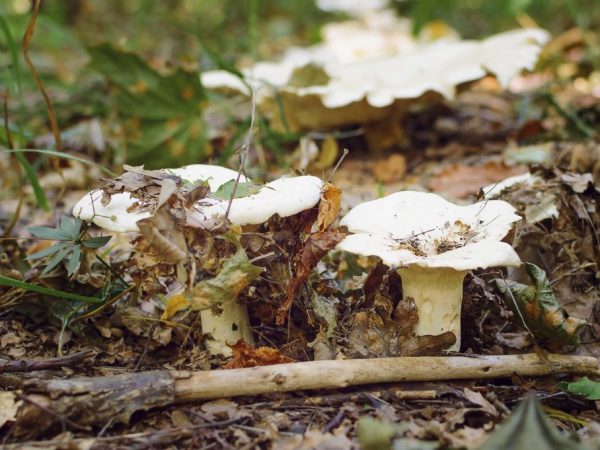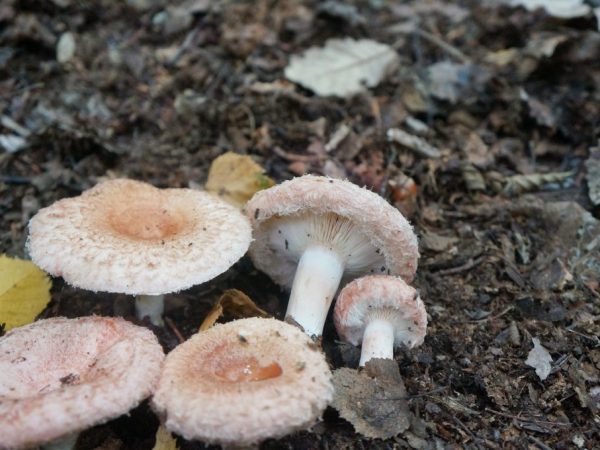Mushroom pickers often collect conditionally edible mushrooms along with edible ones. Their main difference lies in the fact that such fruit bodies can be consumed only after preliminary thorough heat treatment. Some species in this group are suitable for canning. Their taste is often not inferior to popular edible varieties.

Conditionally edible mushrooms
Photos and names of mushrooms
About category
Consider. It is forbidden to try raw mushrooms of this group.
They do not contain toxins and hallucinogenic substances, but they do contain:
- bitter milky juice;
- slightly poisonous substances.
To get rid of these components or neutralize their effect, mushrooms are soaked in salted water or boiled. The fluid must be changed several times. Failure to comply with the processing conditions can result in severe stomach upset. In severe cases, the use of improperly prepared conditionally edible mushrooms is fatal.
Some species are toxic when consumed with certain foods. For example, dung beetle in combination with alcohol causes poisoning.
Conditionally edible organisms are divided into the following types:
- tubular;
- lamellar;
- marsupials;
- undefined.
Application area
Representatives of this category have useful properties. By nutritional value, mushrooms are divided into 4 categories:
- Category 1: those that taste great and contain a lot of proteins, vitamins and minerals.
- Category 2: no less tasty fruit bodies, but slightly inferior to the previous group in terms of the content of useful components.
- Category 3: the species related to it taste good, but their value is low.
- Category 4: have mediocre taste indicators.
Often in diets, those types are used that have a low calorie content. Various dishes are prepared from them, including soups, pates, casseroles, salted and pickled. Some canned mushrooms are eaten only after a certain period of time.
Conditionally edible mushrooms are used for medicinal and prophylactic purposes, used in cosmetology. The usefulness of mushrooms is being studied to this day.
Examples of
It is difficult for an inexperienced mushroom picker to distinguish these species from edible fruit bodies. They have no particular differences. To recognize them, it is worth examining the description of the category representatives.
Autumn oyster mushroom
Other names: green oyster mushroom, alder oyster mushroom, late oyster mushroom.
Fruiting lasts from mid-autumn to mid-winter. The greatest yield is harvested during thaws, when the ambient temperature is 4-6 ˚С. It grows on deciduous wood: aspen, alder, birch, poplar, less often on conifers. It is met in groups.
Worms do not damage autumn oyster mushroom. The cap of the mushroom is slightly mucous, finely pubescent, like the leg. The leg is small, sometimes it may not be there. Only young mushrooms are used for cooking. They are pre-boiled for 20 minutes. Soups, main courses, pickles are prepared from them.
Pink hair

Volnushki must be soaked before use.
Other names: Volzhanka, Rubella, Volzhanka. Grows in colonies in birch groves and mixed forests. Sometimes chooses wet areas. Creates a symbiotic union (mycorrhiza) with birch. Dark concentric circles are noticeable on the cap, the edges are pubescent, curled down. The pulp is brittle with a faint smell of pine resin.
The crop is harvested from the end of June to October, it grows mainly in the northern part of the forest. The peak of fruiting occurs in late July and late August - early September.
Usage rules:
- mushrooms are pre-boiled;
- soak before frying;
- eaten a few months after salting.
Black lump
The second popular name is nigella. Occurs in birch and mixed forests, near roads. It hides in mosses and deciduous litter. Prefers lighted places. The color of the cap is usually darker in the center than the edge, the edge is felt. The pulp turns gray on the cut. Forms mycorrhiza with birch. Grows in large groups from early August to November. The mass harvest takes place in mid-August - early September.
Mushrooms are more often used salted. Canned milk mushrooms acquire a violet-burgundy color and do not lose their taste for 3 years. To remove the bitterness, it is pre-soaked or boiled.
Liverwort ordinary
Received its name for the external similarity with the liver of animals. Grows on oaks and chestnuts. It prefers a warm climate, although it is also found in the northern regions. The crop is harvested from the second half of July until frost.
Irina Selyutina (Biologist):
Liverwort belongs to the 4th category by edibility. Young fruiting bodies are soaked for at least 2.5 hours, after which they are thoroughly washed, mucus is removed from the surface of the cap and the hard stem is cut off. To prepare mushroom minced meat, the previously soaked fruit body is passed through a meat grinder, eggs, a little flour, salt and pepper to taste are added and mixed like ordinary minced meat. It can be shaped like cutlets or used as a filling for dumplings. By the way. If in the forest you find a liver mushroom dried right on a tree, cut it off and use it for cooking. However, at the same time, carefully look at its appearance: if inside it looks like a piece of coal, it is better to leave it.
Young specimens are classified as gourmet products. They contain a large amount of acid, which protects the fungus from the tannins of wood. For this reason, the recipe for their preparation is special:
- they are soaked in salted water from several hours to a day;
- the liquid is periodically changed;
- liverwort preparations are not made.
Bitter
Bitter milkweed, mountain goat weed or bitterness, is found more often in coniferous forests. The cap in young and mature specimens of the same color is dark red or brown-red. Loves acidic soils. Creates a symbiotic union with conifers and birches. Grows in the northern and middle parts of the forest zone. Fruiting is abundant and frequent, lasts from May to November. For your information. Bitter is often confused with a load of camphor and a load of marsh.
It belongs to the 4th flavor category. Has the most pungent taste of all milkmen. The bitter is pickled, salted, but to remove the bitterness, you first need to boil it or soak it.When salted, the fruit bodies become dark brown.
Serushka
Other names: gray lacquer, lilac milk mushroom. Grows in birch and mixed with birch forests. It is found in their northern part, as well as on forest edges, glades, near roads. Collect it from July to October. Grows in groups or individually. Loves wet weather. The cap is yellow, just like the yellow lump of the species. They are distinguished only by the milky juice - in the silver sap it has a purple color when it is broken.
Belongs to category 4. The taste is pungent, pungent. Use salted. Requires pre-soaking.
Dubovik
Deaf boletus or olive-brown oak wood. Grows in deciduous and mixed forests, mainly oak. Creates mycorrhiza with hornbeam, oak, beech. Prefers lighted places. Fruiting from June to September. Massively harvested in August. It is characterized by an interesting feature: the flesh on the cut quickly turns blue-green, and then gradually turns black.
Usually oak wood is dried, pickled, salted. It is not used without prolonged heat treatment because fruiting bodies contain toxic substances. Good taste. It is forbidden to combine the product with alcohol.
Conclusion
It is worth eating conditionally edible mushrooms after a certain treatment. It is better to collect young specimens, not damaged and not wormy. They should be free of mold and mucus. Only familiar species are used for food.




































